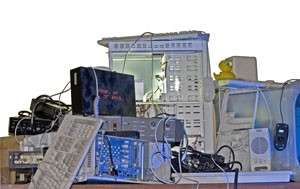With the business and networking pressures placed upon a university conducting world-class research and teaching more than 37,000 students, the UA administration believes its outdated computer systems can no longer be modified to fit today’s needs.
These “”legacy”” systems, some of which are in excess of 30 years old, have been continuously revised to better accommodate payroll data, student information, budget details and business intelligence.
“”With technology that old, it becomes an issue when you need to be able to support the business needs of today, based on today’s Web technologies, with systems that were not even built in that era,”” said Michele Norin, the UA’s chief information officer and executive director of University Information Technology Services. “”So we’re constantly struggling to modify them to be compatible with systems today. The technology is limiting in today’s standards.””
What is a Legacy?
A “”legacy”” system is an old or outdated computer system that remains in place even after modern technology has made it obsolete. Reasons for legacy systems enduring include the financial investment put into them, and the time and resources needed to transfer their typically important data to replacements.
Software packages developed by the Kuali Foundation and PeopleSoft are likely to replace these systems as part of a project estimated to cost $80-90 million, according to a university proposal to go before the Arizona Board of Regents this week.
The board’s Technology Oversight Committee will see the proposal Wednesday, and all the regents during its monthly meeting Thursday and Friday on the UA campus.
If approved, replacement will begin in July.
A key flaw in the systems at present is that “”they don’t ‘talk’ to each other,”” UA President Robert Shelton wrote in an e-mail.
“”They are beginning to have a negative impact on our ability to successfully compete in an environment where most every major university is light years ahead of us when it come to this kind of technology,”” he wrote.
Another significant concern is that the systems have put the UA at risk of non-compliance with the National Science Foundation.
The foundation’s requirements for effort reporting on NSF grants cannot be met, which, without a long-term solution, could jeopardize funding on a variety of future projects, Norin said.
Implementation of the new systems would take place over three years, she said.
“”In general, this is very exciting for us to be able to make this kind of investment,”” Norin said. “”Given the age of our systems, it’s time we do this, and I’m very pleased the institution has provided a commitment to, and the investment for, doing this.””
Students, faculty and staff will all have new, resourceful features available to them upon completion, she said.
“”For example, students will have new capabilities in the self-service portals than what they have today,”” Norin said. “”Student Link will be changed up, and the (UA home page) will be new.””
Another benefit will be the ability for the UA to communicate with the two other in-state universities, as Arizona State University and Northern Arizona University already use PeopleSoft products.
“”There’s a consistency that comes with having the same tools,”” Norin said.
Because ASU has just recently updated its systems, the UA can learn what and what not to do when they embark on the same mission, she said.
“”Technically and business-wise, we can ask them, ‘What did you learn, what did you do and how could we improve?'”” she said.
With replacements of systems this size, there is always a risk of technical problems, Norin said.
“”Projects of this size typically have some glitches,”” she said. “”I’m expecting there to be some, and the challenge will be how we deal with those. We just need to have the proper processes and structures in place so when we hit those, we can quickly deal with them and fix them so they don’t become long-term issues.””
The planning proposal for implementation can be found at cio.arizona.edu/policies/Enterprise_Feb2008.pdf









